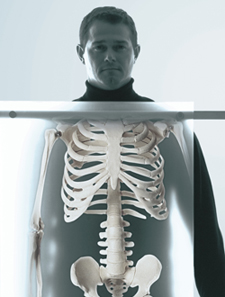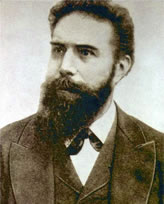Why X-rays?

Rather than lying down, we want X-ray views showing your body in a weight-bearing position.
Both visible light and X-rays consist of photon particles conveyed over electromagnetic energy. When carefully controlled, this energy can be used to reveal the internal structure of the body. We find these pictures quite helpful:
- Provide a structural record of your spine
- Locate fractures or other signs of trauma
- Identify evidence of long term spinal degeneration
- Confirm other examination findings
Interestingly, X-rays were discovered soon after the first chiropractic adjustment in 1895. Wilhelm Roentgen, a German physics professor, was experimenting with cathode ray tubes and discovered that an object across the room began to glow. Much to his surprise, when he placed his hand between the tube and the glowing barium screen, he was able to see the bones of his hand.

Wilhelm Roentgen won the Nobel Prize for Physics in 1901 for the discovery of the X-ray.
- We take only the most necessary views
- Use the most up to date equipment
- Intensification screens reduce energy used
- Filtration removes unneeded frequencies
- Collimation narrows the energy beam
- Sensitive films shorten exposure time
- Shielding protects sensitive body parts
- Equipment is regularly inspected
